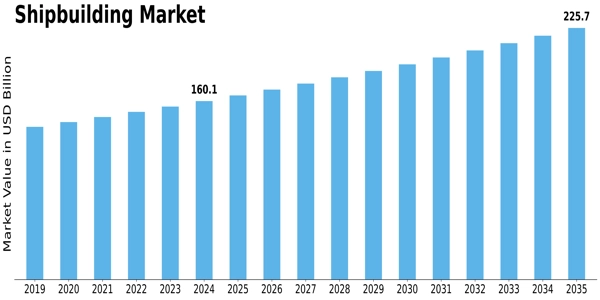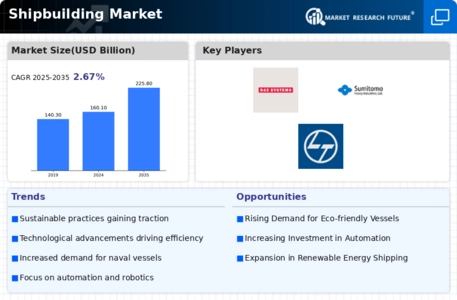-
Executive Summary
-
Market Attractiveness Analysis
- Global Shipbuilding Market, by Ship Type
- Global Shipbuilding Market, by Process
- Global Shipbuilding Market, by End User
- Global Shipbuilding Market, by Region
-
Market Introduction
-
Market Definition
-
Scope of the Study
-
Market Structure
-
Key Buying Criteria
-
Market Factor Indicator Analysis
-
Research Methodology
-
Research Process
-
Primary Research
-
Secondary Research
-
Market Size Estimation
-
Forecast Model
-
List of Assumptions
-
Market Insights
-
Market Dynamics
-
Introduction
-
Drivers
- Rise in international seaborne trade
- Growing maritime tourism industry
- Increasing use of 3D printing in shipbuilding
- Drivers Impact Analysis
-
Restraints
- Issues related to regular maintenance and cleaning
- High materials and operations cost
- Regulations & policies related to environment control
- Restraints Impact Analysis
-
Opportunities
-
Market/Technological Trends
-
Patent Trends
-
Regulatory Landscape/Standards
-
Market Factor Analysis
-
Supply Chain Analysis
- R&D
- Manufacturing
- Distribution & Sales
- Post-Sales Monitoring
-
Porter’s Five Forces Analysis
- Threat of New Entrants
- Bargaining Power of Suppliers
- Bargaining Power of Buyers
- Threat of Substitutes
- Intensity of Rivalry
-
Global Shipbuilding Market, by Ship Type
-
Introduction
-
Cargo
-
Vessel
-
Container
-
Tanker
-
Multi-Purpose Ship
-
Car and Passenger Ferry
-
Others
-
Global Shipbuilding Market, by Process
-
Introduction
-
Designing
-
Production Planning
-
Cutting and Processing
-
Assembling
-
Launching and Outfitting
-
Global Shipbuilding Market, by End User
-
Introduction
-
Commercial
-
Military
-
Global Shipbuilding Market, by Region
-
Introduction
-
North America
- US
- Canada
-
Europe
- UK
- Germany
- France
- Italy
- Russia
- Rest of Europe
-
Asia-Pacific
- China
- India
- Japan
- South Korea
- Rest of Asia-Pacific
-
Rest of the World
- Latin America
- Middle East & Africa
-
Competitive Landscape
-
Competitive Overview
-
Competitor Dashboard
-
Major Growth Strategies in the Global Shipbuilding Market
-
Competitive Benchmarking
-
Market Share Analysis
-
Leading Player in Terms of Number of Developments in the Global Shipbuilding Market
-
Key Developments & Growth Strategies
- Product Launches/Service Deployments
- Mergers & Acquisitions
- Joint Ventures
-
Company Profiles
-
Key Market Players
-
(Company overview, products & services offered, financial overview, key developments, SWOT analysis, and key strategies to be covered for public companies)
-
Raytheon Technologies Corporation
-
Huntington Ingalls Industries, Inc.
-
General Dynamics Corporation
-
Damen Shipyards Group
-
BAE Systems
-
STX Offshore & Shipbuilding Co., Ltd.
-
Sumitomo Heavy Industries, Ltd.
-
FINCANTIERI S.p.A.
-
China State Shipbuilding Corporation Limited
-
DSME Co., Ltd.
-
Other Prominent Players
-
China Shipbuilding Industry Corporation
-
United Shipbuilding Corporation
-
LARSEN & TOUBRO LIMITED
-
Northstar Shipbuilding Pvt. Ltd.
-
TSUNEISHI SHIPBUILDING Co., Ltd.
-
Shanghai Waigaoqiao Shipbuilding Co., Ltd.
-
Samsung Heavy Industries Co., Ltd.
-
Oshima Shipbuilding Co., Ltd.
-
MITSUBISHI HEAVY INDUSTRIES, LTD.
-
MEYER WERFT GmbH & Co. KG
-
Imabari shipbuilding Co., Ltd.
-
Hyundai Heavy Industries Co., Ltd.
-
Hanjin Heavy Industries & Construction Co., LTD.
-
Navantia
-
MV WERFTEN Wismar GmbH
-
Appendix
-
References
-
Related Reports
-
List of Abbreviations
-
-
List of Tables
-
List of Assumptions
-
Major Patents Granted for Shipbuilding (2024–2030)
-
Global Shipbuilding Market, by Ship Type,2024-2030(USD Million)
-
Global Shipbuilding Market, by Process,2024-2030(USD Million)
-
Global Shipbuilding Market, by End User,2024-2030 (USD Million)
-
Global Shipbuilding Market, by Region,2024-2030 (USD Million)
-
North America: Shipbuilding Market, by Country,2024-2030(USD Million)
-
North America: Shipbuilding Market, by Ship Type,2024-2030 (USD Million)
-
North America: Shipbuilding Market, by Process,2024-2030 (USD Million)
-
North America: Shipbuilding Market, by End User,2024-2030 (USD Million)
-
US: Shipbuilding Market, by Ship Type,2024-2030 (USD Million)
-
US: Shipbuilding Market, by Process,2024-2030 (USD Million)
-
US: Shipbuilding Market, by End User,2024-2030 (USD Million)
-
Canada: Shipbuilding Market, by Ship Type,2024-2030 (USD Million)
-
Canada: Shipbuilding Market, by Process,2024-2030 (USD Million)
-
Canada: Shipbuilding Market, by End User,2024-2030 (USD Million)
-
Europe: Shipbuilding Market, by Country,2024-2030 (USD Million)
-
Europe: Shipbuilding Market, by Ship Type,2024-2030 (USD Million)
-
Europe: Shipbuilding Market, by Process,2024-2030 (USD Million)
-
Europe: Shipbuilding Market, by End User,2024-2030 (USD Million)
-
UK: Shipbuilding Market, by Ship Type,2024-2030 (USD Million)
-
UK: Shipbuilding Market, by Process,2024-2030 (USD Million)
-
UK: Shipbuilding Market, by End User,2024-2030 (USD Million)
-
Germany: Shipbuilding Market, by Ship Type,2024-2030 (USD Million)
-
Germany: Shipbuilding Market, by Process,2024-2030 (USD Million)
-
Germany: Shipbuilding Market, by End User,2024-2030 (USD Million)
-
France: Shipbuilding Market, by Ship Type,2024-2030 (USD Million)
-
France: Shipbuilding Market, by Process,2024-2030 (USD Million)
-
France: Shipbuilding Market, by End User,2024-2030 (USD Million)
-
Italy: Shipbuilding Market, by Ship Type,2024-2030 (USD Million)
-
Italy: Shipbuilding Market, by Process,2024-2030 (USD Million)
-
Italy: Shipbuilding Market, by End User,2024-2030 (USD Million)
-
Russia: Shipbuilding Market, by Ship Type,2024-2030 (USD Million)
-
Russia: Shipbuilding Market, by Process,2024-2030 (USD Million)
-
Russia: Shipbuilding Market, by End User,2024-2030 (USD Million)
-
Rest of Europe: Shipbuilding Market, by Ship Type,2024-2030 (USD Million)
-
Rest of Europe: Shipbuilding Market, by Process,2024-2030 (USD Million)
-
Rest of Europe: Shipbuilding Market, by End User,2024-2030 (USD Million)
-
Asia-Pacific: Shipbuilding Market, by Country,2024-2030 (USD Million)
-
Asia-Pacific: Shipbuilding Market, by Ship Type,2024-2030 (USD Million)
-
Asia-Pacific: Shipbuilding Market, by Process,2024-2030 (USD Million)
-
Asia-Pacific: Shipbuilding Market, by End User,2024-2030 (USD Million)
-
China: Shipbuilding Market, by Ship Type,2024-2030 (USD Million)
-
China: Shipbuilding Market, by Process,2024-2030 (USD Million)
-
China: Shipbuilding Market, by End User,2024-2030 (USD Million)
-
India: Shipbuilding Market, by Ship Type,2024-2030 (USD Million)
-
India: Shipbuilding Market, by Process,2024-2030 (USD Million)
-
India: Shipbuilding Market, by End User,2024-2030 (USD Million)
-
Japan: Shipbuilding Market, by Ship Type,2024-2030 (USD Million)
-
Japan: Shipbuilding Market, by Process,2024-2030 (USD Million)
-
Japan: Shipbuilding Market, by End User,2024-2030 (USD Million)
-
South Korea: Shipbuilding Market, by Ship Type,2024-2030 (USD Million)
-
South Korea: Shipbuilding Market, by Process,2024-2030 (USD Million)
-
South Korea: Shipbuilding Market, by End User,2024-2030 (USD Million)
-
Rest of Asia-Pacific: Shipbuilding Market, by Ship Type,2024-2030 (USD Million)
-
Rest of Asia-Pacific: Shipbuilding Market, by Process,2024-2030 (USD Million)
-
Rest of Asia-Pacific: Shipbuilding Market, by End User,2024-2030 (USD Million)
-
Rest of the World: Shipbuilding Market, by Region,2024-2030 (USD Million)
-
Rest of the World: Shipbuilding Market, by Ship Type,2024-2030 (USD Million)
-
Rest of the World: Shipbuilding Market, by Process,2024-2030 (USD Million)
-
Rest of the World: Shipbuilding Market, by End User,2024-2030 (USD Million)
-
Latin America: Shipbuilding Market, by Ship Type,2024-2030 (USD Million)
-
Latin America: Shipbuilding Market, by Process,2024-2030 (USD Million)
-
Latin America: Shipbuilding Market, by End User,2024-2030 (USD Million)
-
Middle East & Africa: Shipbuilding Market, by Ship Type,2024-2030 (USD Million)
-
Middle East & Africa: Shipbuilding Market, by Process,2024-2030 (USD Million)
-
Middle East & Africa: Shipbuilding Market, by End User,2024-2030 (USD Million)
-
The Most Active Players in the Global Shipbuilding Market
-
Contracts & Agreements
-
Mergers & Acquisitions
-
Product/Service Developments
-
Expansions & Investments
-
Joint Ventures & Partnerships
-
List of Figures
-
Market Synopsis
-
Global Shipbuilding Market: Market Attractiveness Analysis
-
Global Shipbuilding Market Analysis, by Ship Type
-
Global Shipbuilding Market Analysis, by Process
-
Global Shipbuilding Market Analysis, by End User
-
Global Shipbuilding Market Analysis, by Region
-
Global Shipbuilding Market: Market Structure
-
Key Buying Criteria for Shipbuilding Technologies
-
Research Process of MRFR
-
North America: Market Size & Market Share, by Country, 2024 vs 2030
-
Europe: Market Size & Market Share, by Country, 2024 vs 2030
-
Asia-Pacific: Market Size & Market Share, by Country, 2024 vs 2030
-
Rest of the World: Market Size & Market Share, by Region, 2024 vs 2030
-
Market Dynamics Overview
-
Drivers Impact Analysis: Global Shipbuilding Market
-
Restraints Impact Analysis: Global Shipbuilding Market
-
Porter’s Five Forces Analysis of the Global Shipbuilding Market
-
Supply Chain: Global Shipbuilding Market
-
Global Shipbuilding Market Share, by Ship Type, 2024 (% Share)
-
Global Shipbuilding Market Share, by Process, 2024 (% Share)
-
Global Shipbuilding Market Share, by End User, 2024 (% Share)
-
Global Shipbuilding Market Share, by Region, 2024 (% Share)
-
North America: Shipbuilding Market Share, by Country, 2024 (% Share)
-
Europe: Shipbuilding Market Share, by Country, 2024 (% Share)
-
Asia-Pacific: Shipbuilding Market Share, by Country, 2024 (% Share)
-
Rest of the World: Shipbuilding Market Share, by Region, 2024 (% Share)
-
Competitor Dashboard: Global Shipbuilding Market
-
Capital Market Ratio and Financial Matrix
-
Contracts & Agreements: The Major Strategy Adopted by Key Players in the Global Shipbuilding Market
-
Benchmarking of Major Competitors
-
Major Service Providers Market Share Analysis, 2024'







Leave a Comment